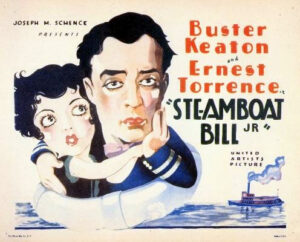This post is my contribution to the Buster Keaton Blogathon on Silent-ology. I like the idea of collaborative blogging, and I’m glad to have a chance to participate. (Updated to link to the new Blogathon post.)
(This post will hopefully attract a lot of silent film fans who aren’t among my regular readers, so I’d like to mention that I regularly present silent films on Twitch with my own real-time accompaniment. The next one will be on March 13 at 8 PM Eastern US time. The movie will be the 1925 The Lost World, preceded by Winsor McCay’s animated Gertie the Dinosaur. I hope you’ll be able to drop in!)
 The Keaton movie I know best is Steamboat Bill, Jr., having accompanied it at the Plaistow, NH library on July 28, 2023. The previous silent I’d accompanied there was Chaplin’s City Lights, and the differences between Chaplin’s and Keaton’s approaches stood out. City Lights tells a story, but it feels like a series of skits put together to comprise a story. The club scene, the robbery scene, and the boxing scene almost stand on their own. Chaplin’s Tramp is pretty much the same from beginning to end. Steamboat Bill, Jr. is more of a continuous story, and Keaton’s character grows a lot during its course. At first he feels out of place, having come from a Boston-area college to a run-down steamboat in the South. By the end, he’s become highly competent and saves four lives. The gags are as important as in a Chaplin film, but they’re more integrated into the plot.
The Keaton movie I know best is Steamboat Bill, Jr., having accompanied it at the Plaistow, NH library on July 28, 2023. The previous silent I’d accompanied there was Chaplin’s City Lights, and the differences between Chaplin’s and Keaton’s approaches stood out. City Lights tells a story, but it feels like a series of skits put together to comprise a story. The club scene, the robbery scene, and the boxing scene almost stand on their own. Chaplin’s Tramp is pretty much the same from beginning to end. Steamboat Bill, Jr. is more of a continuous story, and Keaton’s character grows a lot during its course. At first he feels out of place, having come from a Boston-area college to a run-down steamboat in the South. By the end, he’s become highly competent and saves four lives. The gags are as important as in a Chaplin film, but they’re more integrated into the plot.
If you ran into the Tramp in real life, you’d consider him an odd person, almost living in a world of his own. This gave him resilience and was central to his popularity. If you ran into any of the characters from Steamboat Bill, Jr., you’d find them old-fashioned but similar to real-life people you’ve known. They include the well-meaning but overbearing father, his timid son, the arrogant rich man, and his rebellious daughter.
Whenever I accompany a movie, my main aim is to bring out its character. In this case, it meant showing the relationships among the characters and their reactions to situations. I kept the music restrained until the big storm scene, then let loose as the wind raged and buildings collapsed. My keyboard includes a “thunder” sound, which I used quite a bit.
One bit was problematic. There’s a scene where a black man on a boat is playing a banjo and gets spooked by Keaton’s character coming out of the water. It’s not unreasonable that someone could react that way, but it’s racial humor, and I had to find a way to deal with it. My approach was to play “Swing Low, Sweet Chariot” at a moderate tempo, granting him a little dignity, and then cut it off abruptly.
Perhaps even that needs explaining these days. “Swing Low, Sweet Chariot” was one of the best known of the songs called “Spirituals.” They were the authentic creations of slaves, as opposed to the minstrel-show music that mocked them. Religious in nature, they often carried a thinly disguised message of longing for freedom. The Czech composer Antonin Dvořák thought spirituals could provide a basis for distinctively American music, and he incorporated a tune similar to “Swing Low, Sweet Chariot” into his New World Symphony.
Another scene, where the father is looking among a crowd for his son and mistakenly approaches a black man from behind, isn’t a problem. It’s the father who looks silly.
The best-known moment from the movie comes when the front of a house falls over on Keaton, and he’s saved from major injuries or death only because there’s an open window where he stands. If his position or the course of the building front had been off just a little, he really would have experienced those consequences.
Any movie from a century ago is going to have some issues today. The basics of Steamboat Bill, Jr. still work: adaptation to new situations, competition, love, and courage.

I will have to follow your work. Steamboat Bill, Jr is a fun movie. You are right that the characters seem more normal than those in Chaplin’s films. I’m a silent film fan and a steamboat fan, so this film covers both interests. It was mostly shot in the Sacrameno Delta, where a fleet of steamboats carried passengers and produce.
It’s wonderful to get a silent film accompanist’s perspective, you have insights on the rhythm, pacing, and themes of each film that many people might not pick up on. Thanks for contributing your thoughts on this classic to our blogathon, it’s much appreciated!
Thanks for sharing your thoughts on this film, and how you worked around certain issues in the film. Really interesting to see how an accompanist approaches a silent film.
It’s very cool to see the thought that goes into silent film scores! Steamboat Bill Jr. is such a fun movie. I bet it’s great to see it in a theater setting with that live accompaniment.